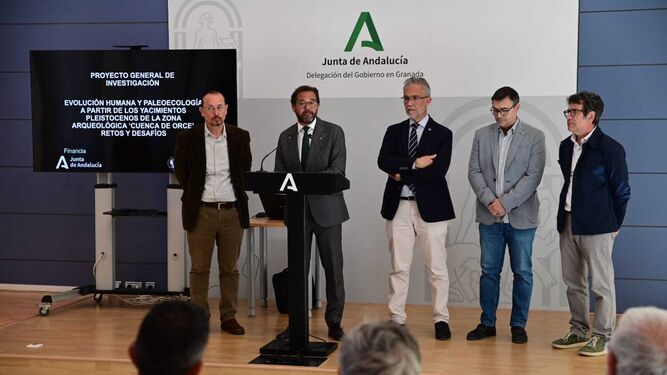The government delegate announces new archaeological activities with a budget of 300,000 euros.
The archaeological zone of Orce is preparing to host a new General Research Project (PGI) under the title 'Human Evolution and Palaeoecology from the Pleistocene sites of the Cuenca de Orce Archaeological Zone : Challenges and Challenges . Networks-Orce'. The aim of this project is to provide continuity to the research carried out in the previous PGI in order to obtain scientific answers, bearing in mind that most of the research team coincides in both cases.
The Government delegate, Antonio Granados, stressed that "the commitment of the Junta de Andalucía has been reinforced even more with Orce as we are talking about a special area in which remains of the first hominid in Europe have been collected" and added that from this area has come "one of our jewels, one of our essentialpieces of the Archaeological Museum", referring to the molar found "which places us as the cradle of mankind in Europe".
For his part, the delegate for Tourism, Culture and Sport, Fernando Egea assured that " a total of 300,000 euros are guaranteed for the next four years, with 75,000 euros each year", and considered that "behind this investment will come other contributions from the UGR itself, from the Junta, by other means, as well as from other entities, in such a way that this will have a multiplying effect on the research, on the study, in all the phases". According to Egea, the interventions will be carried out between June and July.
During the presentation, some of the most important aspects of the project, which has a budget of 75,000 euros per year, were explained. The general objectives of the project are to refine the chronological framework of the first human presence in the westernmost part of the Eurasian continent; to reconstruct, using different approaches and in as integrated a manner as possible, the ecological framework in which the different levels (and even facies) of the Venta Micena 4, Barranco León and Fuente Nueva 3 sites were formed.
This PGI also aims to link the technological changes in lithic carving production with the palaeoecological evolution of the most northeastern part of the Guadix-Baza basin, as well as to unravel, at family and even species level, the modifications carried out by the different biotic agents. In the case of humans, the raw materials used.
This PGI must also include the important task of specifically conserving each of the sites and the materials extracted from them, as well as other tasks aimed at integrating knowledge and disseminating the results, both among peers and to society in general.
This project, which received authorisation from the Directorate General for Historical Heritage and Cultural Innovation and Promotion on 7 March, was presented by the Government Delegate, Antonio Granados, together with the Delegate for Tourism, Culture and Sport, Fernando Egea: the Vice-Rector for University Extension and Heritage, Víctor Medina; the Mayor of Orce, José Ramón Martínez and the director of the project, Juan Manuel Jiménez.
Excavation
The project also has aseries of specific objectives which, in terms of archaeological excavation, include the continuation of the excavation work at Fuente Nueva 3, Venta Micena and Barranco León.
In the first one, the need to rethink the excavation strategy in order to try not to mix different events, due to the complexity of the stratigraphic succession, is raised. In Venta Micena it is proposed to continue the work on the two main depositional events or processes, and in Barranco León the problem revolves around the imminent exhaustion of the excavable surface.
In the previous PGI, it was proposed to deepen the investigation of the regional geology. In this new framework, it is intended to delve into the areas of sedimentology and stratigraphy, which is a key aspect. It will also allow the study and definition of the possible access routes to the Guadix-Baza basin through its most northeastern sector, among many other objectives.
The project, directed by Juan Manuel Jiménez Arenas, attached to the University of Granada, involves the participation of 100 employees and a large number of collaborators, including more than 80 undergraduate and postgraduate students from various specialisations. It also contemplates a complete team of national and international centres and universities covering a wide range of differentiated areas of work.
In this sense, the vice-rector of University Extension and Heritage of the UGR, Víctor Medina, highlighted "the transversal and interdisciplinary nature of the research team working on this project, made up of archaeologists, palaeontologists and geologists, and the excellent level of the scientific publications that the project has produced in these four years, which have also allowed the team to obtain funding of more than 500,000 euros, in addition to the 300,000 euros provided by the Andalusian Regional Government through competitive projects".
https://www.granadahoy.com/provincia/Junta-proyecto-investigacion-yacimientos-Orce_0_1779123371.html


